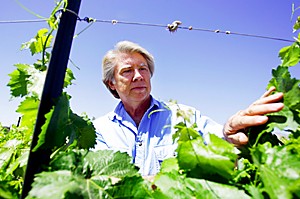The Tucson desert may seem like an unlikely place to harvest grapes, but UA researchers are finding out if the Old Pueblo’s climate holds any secrets to the art of winemaking.
The Vine to Wine program, operated at the UA Campus Agriculture Center, aims to find out if the dry, low-elevation climate will yield a tasty varietal, said John Begeman, an urban horticulture agent with the UA/Pima County Cooperative Extension.
“”We’re doing this as a promotional effort for the wine grape industry,”” Begeman said.
Because of the low elevation, 80 percent of the grapes grown in the program are red.
White grapes typically grow at a higher elevation than the red variety, which are usually grown above an altitude of 4,500 feet as opposed to Tucson’s 2,600 feet, Begeman said.
“”We’re trying to establish if this can be done at a lower elevation,”” Begeman said.
Many of Arizona’s wineries are concentrated in the Wilcox-Sonoita area in Cochise County at a 4,500-foot elevation.
If Vine to Wine’s research is a success, it could turn the winegrower industry on its head.
“”Anything that adds to the quality gives us a leg up on other states,”” said Al Buhl, owner of the Dos Cabezas winery near Wilcox.
Buhl said there is a current trend of growing Italian grapes in California and marketing it as Italian wine.
If a grape can be found to grow well in the Arizona, for example the Tempranillo grape cultivated in Spain, it could mean a boost in business for that kind of varietal, Buhl said.
“”You’d command a higher price, which makes the grapes more valuable,”” Buhl said.
While there are no plans to sell the wine made through the program, Vine to Wine has grown from making a single Shiraz variatal in its first year to growing more than a dozen different types of grapes, including Tempranillo, in its second year of operation, Begeman said.
“”We’re considerably hotter in the summer, and that’s when the grapes produce and color up,”” Begeman said. “”So far we’ve been pretty happy with the results.””
Wines in Arizona began as a novelty, but are now starting to sell as the public becomes more aware of them, said Nicolas Mills, general manager of 58 Degrees Wine Shop in Tucson.
“”I’ll be honest, I didn’t believe it at first,”” Mills said.
One such Arizona vineyard that has enjoyed success is the Echo Canyon Winery in Sedona, which already has a second label, Mills said.
“”Most wineries have to be totally established to have a second label,”” Mills said.
Part of the burgeoning success of Arizona wines comes from getting noticed by prestigious wine raters like Robert Parker, Mills said.
“”Frankly, the ratings are the proof in the pudding,”” Mills said.
The long-range plans for Vine to Wine include public outreach programs.
“”Another aspect of this program is to begin offering classes to the general public on growing your own wine grapes and making your own wine at home,”” Begeman said.
The classes, which won’t begin until Fall 2007, will use the on-site vineyards and winery located near the corner of Roger Road and Campbell Avenue, Begeman said.
Vine to Wine is operated by 25 volunteer master gardeners who are each responsible for fertilizing, watering, pest control and harvesting their own section of the vineyard, Begeman said.
Grape-growing season begins in late March and early April and concludes with the harvest in July and August when the grapes have fairly high sugar content, Begeman said.
While not all space is currently used, at full capacity the vineyards at the Campus Agricultural Center could yield about 500 cases of wine, Begeman said.









